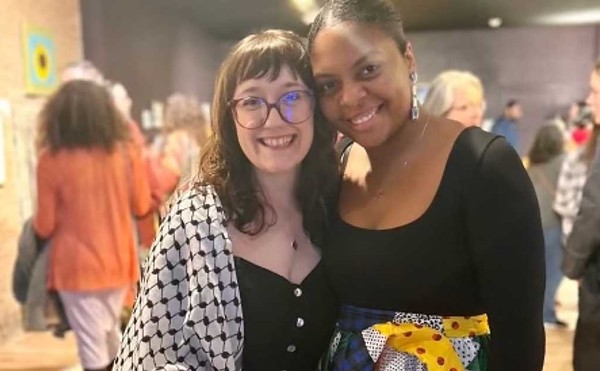Dressed all in black, wearing the angular bob of Uma Thurman’s character in Pulp Fiction, Miroslawa Sztuczka looks as dark and brooding as her artwork — a series of paintings and drawings with expressive, violent linework, and bold, dark colors. Fortunately, she’s not so scary once we start to talk with her.
Sztuczka is speaking with the help of her friend Izabela Nychter. Sztuczka can understand our questions, but she prefers to speak in Polish — she only moved to Hamtramck from Poland three years ago. The two women serve as amusing foils to each other, with Sztuczka often stoic and Nychter interjecting her own comic asides (“I cannot be an artist because I don’t suffer. I don’t suffer because I am a fan of the single malt scotch, and that makes me smile every time,” she says of her supporting role as an art appreciator). The two women are also prone to arguing in a mix of Polish and English, debating at length the spirituality of mathematics and Nychter constantly goading Sztuczka to try to speak in English.
Sztuczka’s story is a little different from most of Hamtramck’s Poles: While the town’s historically Polish majority came to prominence during the auto industry boom of the 20th century, the last decade has seen their numbers slip to a minority. Sztuczka’s relatives had already lived in the United States since the 19th century, and her grandparents moved from this country back to their ancestral Poland, where Sztuczka’s mother was born.
Nevertheless, Sztuczka has found a supportive community among Hamtramck’s declining Polish population — since arriving she has shown her work in Polonia Restaurant, and her upcoming show at the Hamtramck Public Library came about when she started conversing with a Polish librarian.
Sztuczka, Nychter tells us, means “trick,” but it can also mean “art” — which is too perfect, as Sztuczka comes from a very artistic family. Her sister is an opera singer, her other sister is an actress and writer, her nephew is a composer, and her teenage son is studying design. Sztuczka says her parents were always very supportive of art — her father was a singer, and her mother was an actress for a time, but they couldn’t pursue it. Sztuczka’s husband supports the family, working in the salt mines under Detroit.
Sztuczka studied art in Poland, the only student in her class to graduate with a focus on drawing, and her background has stuck with her. “She likes to do it with knife,” Nychter says of Sztuczka’s paintings. “She uses knife mostly because it imitates the drawing — the straight, sharp lines.” The focus on stark linework gives Sztuczka’s work an emotional, almost unhinged quality. “She was always interested in the psychopathology of expression; art is a healing [medium],” Nychter explains, adding that Sztuczka has always been fascinated by art created by the mentally ill.
Sztuczka is reluctant to discuss the meaning of her work directly. “She says she’s not imposing anything on people. She thinks anyone can find something for themselves [in her work],” Nychter explains, though it’s hard not to trace a line from the titles of Sztuczka’s series — “Apocalypse” and “Degradation of Femininity” — to the scenery of nearby Detroit.
When asked about her impressions of Detroit as an immigrant, Sztuczka says she feels it’s too early for her to comment. Nychter only adds, “We come from large cities in Europe. My first contact with Detroit was during lunch hour downtown, full of people. An hour later it was empty. I thought something happened, that there was some sort of disease or a bomb. How can you even have a city without having to maneuver your way around people?”
Sztuczka works at home out of a basement studio. She says she works fast, and that one of her teachers, the famous Polish artist Franciszek Starowieksi, taught her to draw with both hands at the same time — if you draw with one hand, you are limited to a range of motions, she says. Sztuczka says she also writes, but is waiting until she gets better at English before she incorporates it into her art, citing Faulkner, David Lynch, Lars von Trier, and Quentin Tarantino as influences. (Hmm, maybe that black bob is a Pulp Fiction homage.)
Miroslawa Sztuczka’s exhibition has an opening reception at 4 p.m. on July 11, at Hamtramck Public Library; 2360 Caniff St., Hamtramck. There will be cookies.






